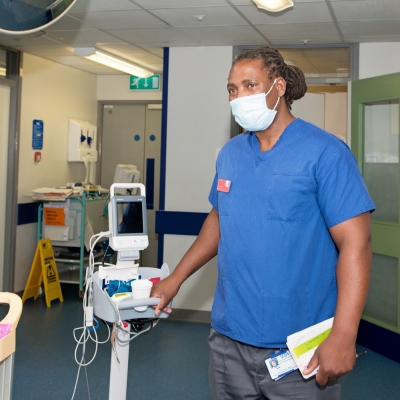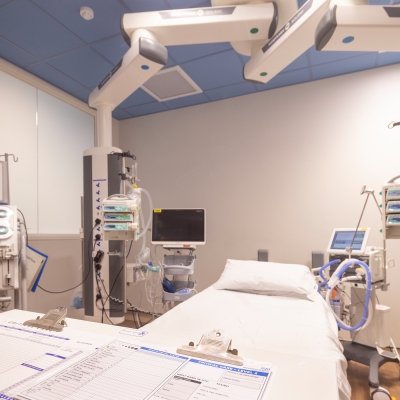About
Audiology is all about the science of hearing and balance. We work closely with Ear Nose & Throat, Paediatric Audiology, Newborn Hearing Screening programme and the Deafness Support Network.
Friendly staff who put me at ease. On time against the appointment time. Everything was explained fully and clearly. Excellent service. - feedback from a patient
Self-Referral
You may now be able refer yourself to Audiology for a hearing assessment if you are 55 years or older.
If you are experiencing any of the following symptoms you must seek a referral from your GP and cannot self-refer:
· If you have an ear infection
· Pain affecting your ears
· Previous surgery on your ears
· If you suffer from dizziness or vertigo
· If your hearing is significantly worse in one ear
· If you hear any troublesome noises (tinnitus) affecting only one ear
· You have had a hearing assessment within the last 3 years
If you have a sudden or rapidly progressing hearing loss in one or both ears please seek an urgent GP referral to Ear Nose and Throat or attend your local Accident and Emergency department.
Before completing this form, please follow the link below and complete the RNID Hearing Check to determine if you may have a hearing loss.
If the hearing check suggests you may have a hearing loss and you wish to be seen by the Audiology Service at Mid Cheshire Hospitals NHS Foundation Trust, please complete this self-referral form here.
maintenance
If you require tubing and/or batteries, please send a self-addressed envelope, with a large letter stamp and we will post these items out to you.
If you require a repair that cannot be completed by post, we are now operating open repair sessions. These will take place at Leighton Hospital only during the following times:
- Monday, Thursday and Friday 9am - 11am
- Tuesday and Wednesday 1.30pm - 3.30pm
- Closed during bank holidays
Please note we are unable to complete repairs outside of these times. If you are unable to attend during these times due to work commitments, we can offer a booked repair appointment outside of these times including Saturdays.
Please note, services at Victoria Infirmary, Northwich (VIN) are by appointment only.
If you need further advise, please call 01270 612197 or email audiology
Audiologist attitude very friendly, competent, efficient. The outcome of my assessment was fully explained to me and my questions were answered. Very good service on the day - and on all previous occasions. The service is incredibly important to me as Im sure it is to other attendees. - feedback from a patient
Regular maintenance of your hearing aid is important to ensure you get the most from your hearing aid. Daily cleaning with a wet wipe, damp cloth or tissue is important. Dependant on the type of hearing aid you have you will also need to contact us every 4-6 month for replacement parts. Useful videos of various aspects of hearing aid maintenance can be found at c2hearonline.com
If you have an open fit hearing aid (thin tube) you should attend a maintenance clinic every 6 months to have the tubing and dome replaced.
If you have a mould (thick tube and earpiece) you should attend a maintenance clinic every 4-6 months to have the tubing replaced.
Please contact us by phoning 01270 612197 or emailing audiology
Additional Accessories
We offer a range of accessories available to purchase in the department, to help you maintain, and get the most out of your hearing aids.
-
Hearing aid care tools
-
Custom earphones
-
Custom swim plugs
-
Ear Protection
What is Hearing Loss?
Age Related Hearing Loss
Hearing loss comes about in a variety of ways, the most common being age related hearing loss (or presbyacusis). Age related hearing loss is due to wear and tear damage of the hair cells that detect the sounds within the cochlear. This affects our ability to hear particular frequencies at normal levels, and thus there is a loss of hearing at these frequencies.
Noise Induced Hearing Loss
Exposure to noise is another common cause for hearing loss, known as noise induced hearing loss (NIHL). This is caused by being exposed to excessively loud sounds for a long duration of time, most likely affecting those working in industrial scenarios. This type of hearing loss is now being combated by the use of ear defenders, and noise protection ear plugs.
Conductive Hearing Loss
A conductive hearing loss is caused when there is a blockage along the mechanism of hearing (the outer or middle part of the ear). This can be caused by a range of things, from wax and infection, to trauma to the ear drum, or fixation of the ossicles. This can be a temporary or permanent hearing loss, depending on the cause. Often you will be seen by a medical practitioner to determine the cause for this conductive hearing loss.
Genetic Hearing Loss
There is also genetic hearing loss, a hearing impairment passed along in the genes. This can be present from birth, or sometimes may become present later in life. Alternatively, hearing loss may be associated with a particular syndrome, this will be considered alongside a range of other characteristics before a diagnosis is made.
Anatomy of The Ear
The ear is made up of three different parts. The outer ear, the middle ear and the inner ear.
-
The outer ear is made up of the part we can see called the pinna and the ear canal which leads down to the ear drum.
-
The middle ear is a space filled with air behind the ear drum, where the three smallest bones in the body, the ossciles, are suspended. There is also a tube connecting the middle ear space to the throat called the Eustachian tube.
-
Finally, the inner ear, known as the cochlear, transfers the vibrations of the sound waves that pass through the outer and middle parts into an electrical stimulus that is sent along the auditory nerve and is interpreted by the brain as sound.
How it all works
A sound wave is collected by the pinna and guided along the canal to the ear drum. The ear drum then vibrates with the sound pressure of the sound waves which in turns moves the ossciles in a lever action. The ossciles work as a lever mechanism to transfer the sound wave vibrations into the inner ear (cochlear) which is filled with fluid. This fluid then vibrates also, stimulating small hair cells within the cochlear which trigger the firing of neurons. This firing of neurons passes the signal along the nerve to the brain. The sound is then processed by the brain.
How Does Hearing Loss Affect Your Communication?
A hearing loss impacts our ability to distinguish sounds at normal levels. In speech the frequency and intensity varies depending on the speech sound, for instance the word ‘spoon’, the ‘sp’ is a higher frequency sound, compared to the ‘oon’ which is a lower frequency sound. This means that if you have a hearing loss of the higher frequencies you will miss the speech sounds in this area hearing only the ‘oon’ part of the word. This means that the processing of the word becomes more difficult as your brain has to fill in the missing part. Sometimes you will get this right, but others you may get this wrong leading to mishearing of the word, and possibly not understanding what has been said.
When we are hearing in a noisy environment there are other sounds competing with signal you are trying to listen to, masking the speech further. This often leads to greater difficulties in noisy environments as your brain is being asked to fill in a bigger and bigger gap, increasing the chance of you getting the answer wrong.
What to Expect From Your Hearing Aid
Hearing aids work by taking the sound someone with hearing loss is struggling to hear and making it louder, thereby allowing them to hear.
The hearing aid is set to a prescription level based on the hearing test results. The hearing aid will amplify the sounds to an audible level, whilst aiming to reduce background sounds and increase the speech signal. The hearing aids have adaptive technology to try and provide the best signal-to-noise ratio possible. Sometimes the environment that you are in will not allow the hearing aid to pick out one speech sound over another, making it a more difficult listening situation.
A hearing aid will sound a little alien to start, as it will be digital sound that you hear, not natural hearing. Your brain will recognise the change in sound, and alert you to this, paying more attention to everyday sounds that you may not have heard for some time. This will begin to settle over time, as your brain re-learns which sounds are important and which are not. This is the processing aspect of hearing and listening and this takes time to adjust to. A key point to understand is that hearing aids amplify the sounds around you; it is your brain that will decide which of these sounds to listen to.
For more information about hearing aids please click here.
One vs Two Hearing Aids
Based on your hearing test your audiologist will advise you whether one or two hearing aids are necessary. They will consider a number of factors alongside the hearing loss when making this decision.
Two Aids
When offered two hearing aids some people may think this means that there hearing must be much worse than someone with only one hearing aid. This is not the case, there are benefits to having two hearing aids, so where possible the audiologist will encourage you to try two hearing aids to gain maximum benefit.
Two hearing aids helps to maintain the balance of hearing from left to right to help you in a number of ways, such as localising where a sound has come from, better speech intelligibility in noise, and better sound quality.
One Aid
With one hearing aid, if you have a hearing loss in both ears, you are asking one ear to do the job of two. This puts strain on the ear with the hearing aid, and also deprives the other ear of stimulation.
If you are only offered one hearing aid there may be reasons for this, such as hearing loss in only one ear (unilateral hearing loss), one ear may be unsuitable for a hearing aid in some way. Please speak to you audiologist at this time who will be happy to explain.
Limitations for Hearing Aids and Hearing Loss
Although the technology in hearing aids is greatly improved, they are still only electronic aids to natural hearing. If a patient has very poor natural hearing there is only so much the hearing aid can do. The hearing aids still utilise the patient’s natural outer, middle and inner ear, including the hearing nerve so if there is damage to the hearing nerve the hearing aids are not able to counteract this.
As the hearing aid is an electronic device the sound can sometimes seem not ‘natural’ when it is first fitted. However, if the patient wears the aid regularly this sense can quickly fade. Often the patient will notice a difference in their own voice, this too will fade as the patient adapts to the new sound.
The hearing aid will amplify the sounds around you. Sometimes there will be sounds that you do not wish to hear, you will need to learn how to filter these sounds out. This is something the hearing aid will try to help with, however it will not be able to understand which sounds you do and do not wish to hear.
Some people find it more difficult than others to filter sounds. This is not something that can be changed by the hearing aid. There are however a number of listening tactics that you can employ to help in these more challenging listening situations.







